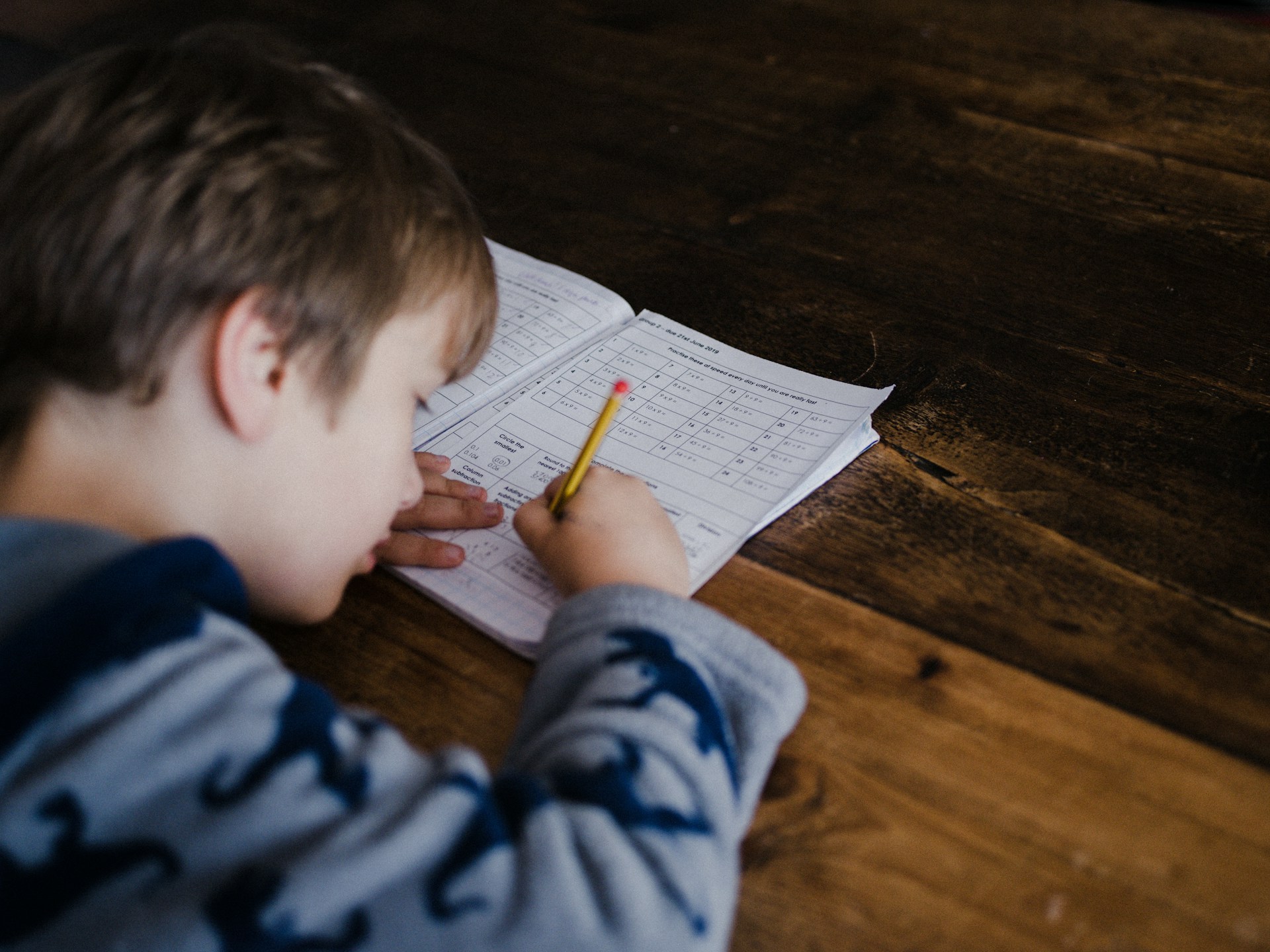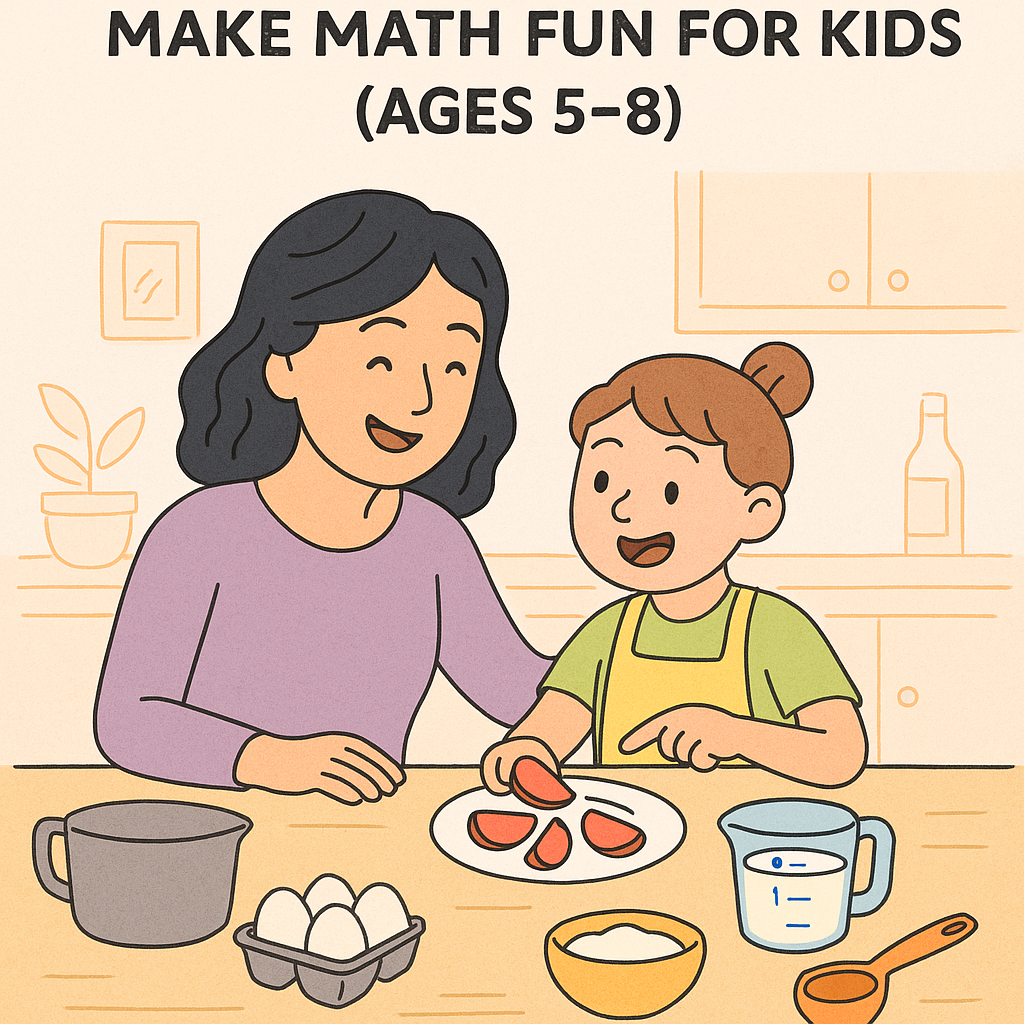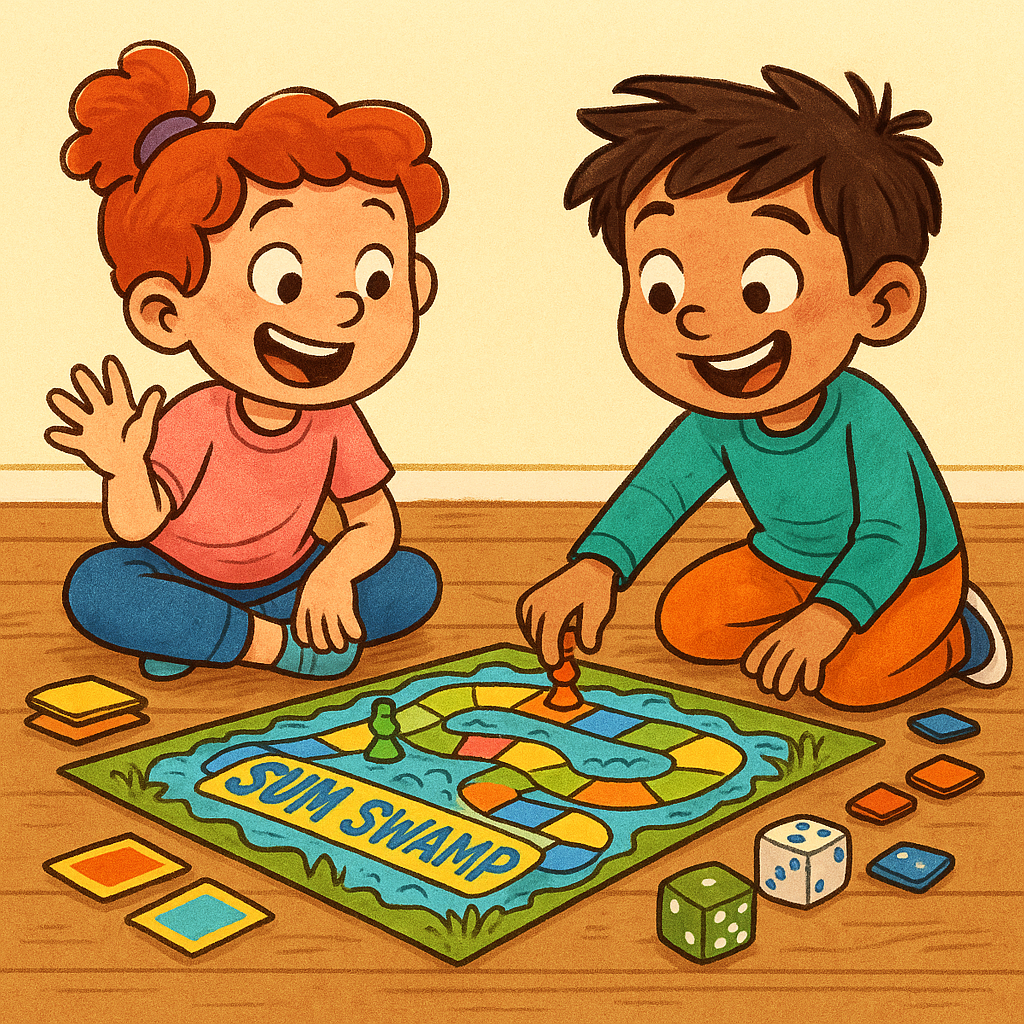5 Everyday Ways to Make Math Fun for Kids (Ages 5-8)

Math is everywhere in our daily lives, even if we don’t always notice it. That’s great news for parents because we can talk with our kids about math in fun, natural ways during everyday activities. In fact, early exposure to casual “math talk” and play can build comfort with numbers from a young age. The bottom line: helping your 5-8 year-old see the joy in math now can set them up to be confident learners later on.
Below are five parent-tested ideas to weave math into your daily routine.

1. Make the Kitchen a Math Playground
Cooking and baking are perfect opportunities for sneaky math practice. Kids love helping in the kitchen, and measuring ingredients or counting items turns meal prep into a hands-on math lesson. You can’t help but use math when you cook – doubling a recipe means multiplying, halving a recipe means dividing, and measuring a ½ cup or ¼ teaspoon introduces fractions.
For instance, if a pancake recipe calls for 1 cup of milk, ask your child how many ½-cup scoops make a full cup.
Let them count spoonfuls, cups, and pieces:
“We need 3 teaspoons of sugar – can you count them out loud?”
Young kids might simply count eggs or push buttons on a kitchen timer (practicing number recognition), while older ones can tackle adding fractions (e.g. “we used ¼ cup, how much more to make 1 cup?”).
- To make it fun, turn tasks into mini-challenges or guessing games. For e.g.
“How many baby carrots do you think will fill this measuring cup?”
Have your child estimate, then count together to see how close the guess was.
- Compare the sizes of measuring spoons or cups and talk about how two ½ cups equal one whole.
- You can also introduce simple multiplication by using groups: “We have 2 people and each needs 3 apple slices – that’s 2 × 3, so how many slices should we cut in total?”
- If you’re baking cookies, let your child decorate one cookie with 5 chocolate chips and another with 10, then discuss which has more and by how many.
These casual conversations build number sense without any pressure.
Tip: Keep it playful and patient. Expect spills and messes as part of the learning! By involving your child in cooking, you’re not only getting help with dinner – you’re showing them how math is useful in real life. And nothing beats eating your “math lesson” as a reward.
(For more ideas on kitchen math fun, the nonprofit Bedtime Math Foundation offers daily kid-friendly “math problems” that often involve food and everyday scenarios.)
2. Turn Chores and Errands into Math Games
Routine chores and errands can hide all sorts of math practice. Kids love feeling helpful, so involving them in tasks like shopping, laundry, or setting the table can become a game of numbers and patterns.
For example, laundry day is great for sorting and counting. Have your child match socks into pairs and count how many pairs they find (instant practice in counting by 2s!). Ask, something like –
“If we have 7 pairs of socks, how many individual socks is that?”
Some examples –
- Folding clothes can include grouping items (“Let’s put shirts in one pile of 5 and pants in another – which pile has more?”) or making patterns with colors. Young helpers can also count the number of towels or sort laundry by size or color, building early classification skills.
- A daily chore like setting the table offers counting practice too. Let your child count out plates, cups, and forks for each family member. If you have guests coming, they can practice simple addition or multiplication (“We have 4 people and each needs a plate, cup, fork, and spoon. How many items is that in total?”). They’ll also start to notice shapes: “The plates are circles, the napkins are rectangles.”
- Don’t forget errands like grocery shopping. Next time you’re at the store, turn your child into a “math helper.” Kids can find numbers and practice simple calculations as you shop. Ask them to weigh fruits and read the scale (“We need 2 pounds of apples – can you tell me when the scale says 2.0?”). While shopping, challenge your child to keep a running cost tally: “We’ve put 3 items in the cart. Roughly, how much do you think we’ve spent so far?”
Younger kids might just compare which of two items costs more, while older kids can add prices (with or without a calculator’s help). Estimating the total bill and then seeing the actual amount at checkout can become a game – were we close? Encourage them to help find numbers on signs and price tags, count the coins in your change, or figure out simple deals (“These yogurts are $1 each or 4 for $3 – which is cheaper for 4 yogurts?”).
These low-pressure, real-world tasks show kids how math helps us make everyday decisions.
3. Play Math Games (Board Games, Outdoor Games, and Made-Up Games)
Playtime is learning time in disguise, especially when you introduce games that involve math. Children learn best through play and hands-on activities, so games are a natural way to make math fun. The options are endless – from classic board games and card games to silly outdoor games you invent on the fly. The key is to sneak in some numbers and logic while everyone is enjoying themselves.
Family board games are fantastic for practicing math without it feeling like a lesson. Games like Monopoly Junior, Yahtzee, Chutes and Ladders, Uno, or Connect Four have kids counting spaces, adding dice, recognizing patterns or numbers, and strategizing – all while having fun.
For example –
- Uno helps younger kids recognize numbers and colors, and they’ll inadvertently practice matching and simple addition (when adding up points).
- Yahtzee or Sum Swamp are great for basic addition. Even Snakes and Ladders gets kids comfortable with number sequences. Many of these games involve a bit of luck and a bit of math, which keeps kids engaged and motivated to practice without realizing it.
- If you’re playing a game like Monopoly, let your child be the banker – counting out money for each transaction is invaluable addition and subtraction practice (and kids adore being in charge of the money!).
Card games are another easy win. A simple deck of cards can be used for games like “War”, where each player flips a card and the higher number wins – great for number comparison. You can modify War to practice addition: each player flips two cards and sums them; highest sum wins.

Outdoor play lends itself to math as well.
- Sidewalk chalk is your friend here: you could draw numbers or shapes on the ground and come up with active challenges (like “hop to the even numbers” or “run to a shape that has three sides”).
- You could also do a number scavenger hunt in the backyard or park, asking your child to collect 6 small rocks, 3 yellow leaves, etc., then count and sort them together.
- Shooting hoops or throwing balls? Count each throw and even introduce early multiplication by saying “we made 2 baskets in a row, let’s try to make 2 more – that would be 4 total!” If your child is into sports or dancing, you can incorporate counting beats, calculating scores, or measuring distances.
The goal is to show that math isn’t just a school subject – it’s a natural part of games and play. By turning math into a game, you’ll likely find your child asks you to play again and again. (And when they do, you can secretly cheer, knowing that practice is building their skills and confidence each time.)
4. Explore Math Through Stories, Reading and Art
Not all math learning has to look like numbers and equations. Stories, imagination, and art can be wonderful vehicles for math concepts, especially for young kids who love a good tale or creative project. Incorporating math into storytime or craft time shows kids another side of mathematics – one that involves curiosity, creativity, and even humor.
- Reading together is a nightly routine for many families, so why not slip in a little math? There are plenty of engaging children’s books that introduce math ideas in a fun way. For the 5-8 age range, you might find storybooks where characters go on adventures involving counting or puzzles. Classics like “Each Orange Had 8 Slices” (by Paul Giganti) teach counting and multiplication through picture scenarios, or “Pete the Cat and His Four Groovy Buttons” (by Eric Litwin) which sneaks in subtraction as Pete loses his buttons one by one. After reading, you can ask questions like, “How many buttons does Pete have left?” or “What would happen if he found 2 more buttons – how many would he have then?”
- Encourage your child to imagine themselves in the story: “If you had 8 slices of orange and gave 2 to your brother, how many would you have left?” These conversations make math feel relatable and part of the narrative, rather than a quiz. Kids also love math-themed rhymes and songs – think of the classic “Five Little Monkeys Jumping on the Bed” (a countdown song) or “This Old Man” (counting up). Sing them, act them out, and let your child take the lead in figuring out what number comes next.
- Arts and crafts also present math moments. Drawing, building, or crafting inherently involve shapes, sizes, and patterns. Next time your child is coloring or drawing, talk about the shapes they’re making (“I see you drew a house – it has a triangle roof and a square window!”). If you’re doing a craft, you can practice counting supplies (“We need 10 beads for this bracelet. How many have we put on so far? How many more do we need?”). Play with symmetry by painting one half of a paper and folding it – then open to see a symmetrical pattern (kids find this magical!). Cutting snowflakes or shapes out of paper is a chance to discuss geometry in a simple way.
You’ll likely find they start spotting and talking about numbers and shapes all on their own during playtime.
5. Embrace Technology and Apps for Interactive Math Fun
A bit of screen time can go a long way when it comes to learning – if you choose the right content. Educational math apps and online games can reinforce skills through playful, interactive experiences. The idea is not to replace real-world learning, but to supplement it. For kids ages 5-8, a colorful math game on a tablet can feel like a treat, and there are many high-quality options designed to boost number skills while keeping kids entertained.
For example –
- Monster Math helps kids build Math Fact fluency, while turning it into an adventure.
- PBS KIDS app and website have free math games featuring popular characters, which can be great for preschoolers and young elementary kids.
- Khan Academy Kids is another free app that offers a broad range of math (and reading) activities in a playful format, complete with cute animal guides and stickers as rewards.
Trying a few different apps to see which one your child enjoys most is worthwhile. When a child finds an app engaging, they’ll likely use it willingly, turning screen time into learning time without any arm-twisting from you.
In addition to apps, don’t forget about simple technology like calculators or digital timers.
- Let your child play with a basic calculator and “discover” numbers – ask them to punch in 2 + 3 and see the result, or explore the idea of 10 + 0, 10 + 1, 10 + 2, noticing patterns in the results. It feels like a game and gives them a sense of autonomy (big kids get to use calculators, after all).
- If you’re cooking or cleaning, a digital timer can be a fun way for a child to practice reading numbers and understanding time (have them set a timer for 2 minutes for a quick cleanup challenge). These little tech tools make kids feel grown-up and turn abstract concepts into something they can manipulate.
Keep it balanced: We recommend treating math apps and tech as one of many tools. It’s great to have a lively math app for your child to play, but also continue the real-world activities listed in the earlier tips – each type of learning reinforces the other.
Making math fun at home is all about seeing the opportunities hidden in everyday life. Whether it’s counting out stuffed animals for a tea party or measuring ingredients for pancakes, these little moments demystify math and show your child that learning is all around us. Remember, the goal at this age isn’t to race through worksheets or push advanced concepts – it’s to build a strong, positive foundation. When kids smile or laugh during a math activity, when they take pride in solving a small problem, you’re doing it right!
Frequently Asked Questions
Q: My child says “I hate math.” How can I turn that around?
A: First, know you’re not alone – many kids feel this way at some point. Try to shift the focus from “getting answers right” to playing with numbers. Games, cooking, and storytelling are all ways to let your child experience small wins. Celebrate effort and progress, not just scores. Over time, they’ll start to associate math with fun, not frustration.
Q: How much time should I spend on math at home each day?
A: For ages 5-8, short and playful is best. Even 10-15 minutes of fun math talk or a quick game can make a big difference. The key is frequency and positivity – sprinkle math into daily life rather than scheduling long sessions. Everyday consistency matters more than duration.
Q: What if my child struggles with focus or gets frustrated easily?
A: Keep activities hands-on and interactive. Use movement, stories, or visual aids rather than just worksheets. Apps can also help because they adjust the difficulty level and give instant rewards, which keeps kids engaged. Break activities into small steps, and let your child take breaks when needed.
Q: My child is already ahead in math. Should I still do these activities?
A: Absolutely! Even advanced learners benefit from seeing math in real life. Activities like cooking, board games, or scavenger hunts challenge kids to apply their skills in new contexts. Plus, it keeps their enthusiasm alive. You can always make activities more complex (e.g., doubling recipes instead of just measuring, or inventing harder riddles).






